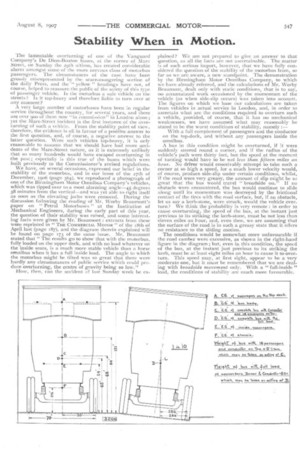Stability When in Motion.
Page 9

If you've noticed an error in this article please click here to report it so we can fix it.
The lamentable overturning of one of the Vanguard
• Company's De Dion-Bouton buses, at the corner of Mare Street, on Sunday the 29th ultimo, has created considerable alarm amongst some of the more nervous class of motorbus passengers. The circumstances of the case have been grossly misrepresented by the scare-mongering section of the daily Press, and the " yellow " headings have not, of course, helped to reassure the. public of the safety of this type of passenger vehicle. Is the motorbus a safe vehicle on the streets? Is it top-heavy and therefore liable to turn over at any moment ?
A very large number of motorbuses have been in regular .service throughout the country, for several years, and there are over goo of them now "in commission" in London alone ; yet the Mare-Street incident is the first instance of the overturning of such a vehicle. From the stability point of view, therefore, the evidence is all in favour of a positive answer to the first question, and, of course, a negative. answer to the latter question. Were such vehicles top-heavy, it is only reasonable to assume that we should have had more accidents of the Mare-Street nature, as it is extremely unlikely that so many hundreds would have escaped overturning in the past ; especially is this true of the buses which were built previously to the Commissioner's revised regulations.
We have, on several occasions, expressed our belief in the stability of the motorbus, and in our issue of the 27th of December, 1906 (page 364), we reproduced a photograph of one of the Birmingham Motor Omnibus Company's vehicles, which was tipped over to a most alarming angle-45 degrees 58 minutes from the vertical—and was yet able to right itself as soon as the elevating jacks were removed. During the discussion following the reading of Mr. Worbv Beaumont's paper on " Petrol Motorbuses " at the Institution of Mechanical Engineers, during the early part of this year, the question of their stability was raised, and some interesting facts were given by Mr. Beaumont : extracts from these were reprinted in 'THE COMMERCIAL MOTOR Of the 18th of April last (page 187), and the diagram therein explained will be found on page t73 of the same issue. Mr. Beaumont stated that" The results go to show that with the motorbus, fully loaded on the upper deck, and with no load whatever on the inside seats, is a much more stable vehicle than a horse omnibus when it 'has a full inside load. The angle to which the motorbus might be tilted was so great that there were hardly any circumstances of public service which could produce overturning, the centre of gravity being so low." How, then, can the accident of last Sunday week be ex plaincd? We are not prepared to give an answer to that question' as all the facts are not ascertainable. The matter is of such serious import, however, that we have fully considered the question of the stability of the motorbus from, so far as we are aware, a new standpoint. The demonstration by the Birmingham Motor Omnibus Company, to which we have already referred, and the calculations of Mr. Worby Beaumont, dealt only with static conditions, that is to say, no accumulated work occasioned by the momentum of the vehicle (as when side-slip occurs') was taken into account. The figures on which we base our calculations are taken from vehicles in actual service in London, and, in order to ascertain what are the conditions required to overturn such a vehicle, provided, of course, that it has no mechanical weaknesses, we have assumed what may reasonably be stated to be the worst conditions of stability, namely :—
With a full complement of passengers and the conductor on the top-deck, and without any passengers inside the omnibus.
A bus in this condition might be overturned, if it were suddenly steered round a corner, and if the radius of the vehicle's path were thirty feet, but the speed at the moment of turning would have to be not less than fifteen miles an hour. No driver would conceivably attempt to take such a corner at so high a speed, for a much lower velocity would, of course, produce side-slip under certain conditions whilst, if the road were very greasy, the amount of slip rnight be so great that the bus would travel " broadside on.' If no obstacle were encountered, the bus would continue to slide along until its momentum was destroyed by the frictional contact of the tires with the road surface, but, if an obstacle, let us say a kerb-stone, were struck, would the vehicle overturn? We think the probability is very remote : in order to cause overturning, the speed of the bus, at the instant just previous to its striking the kerb-stone, must be not less than eleven miles an hour, and, even then, we are assuming that the surface of the road is in such a greasy state that it offers no resistance to the. sliding motion. The conditions would be somewhat more unfavourable if the road camber were excessive, as shown in the right-hand figure in the diagram ; but, even in this condition, the speed of the bus, at the instant just previous to its striking the kerb, must be at least eight miles an hour to cause it to overturn. This speed may, at first sight, appear to be a very moderate. one, but it must be remembered that we are dealing with broadside movement only. With a "full-inside load, the conditions of stability are much more favourable.




















